Falls among the elderly, whether at home or in specialized institutions, are frequent and unfortunately have many repercussions on the autonomy of seniors. In fact, falls are the 3rd most common cause of admission to acute care and the leading cause of fatal accidents among seniors. Thus, it represents a real scourge resulting from various personal, behavioral or environmental factors.
What are the causes? What are the direct and indirect consequences of a fall in the elderly? How can falls be prevented and detected before they happen?
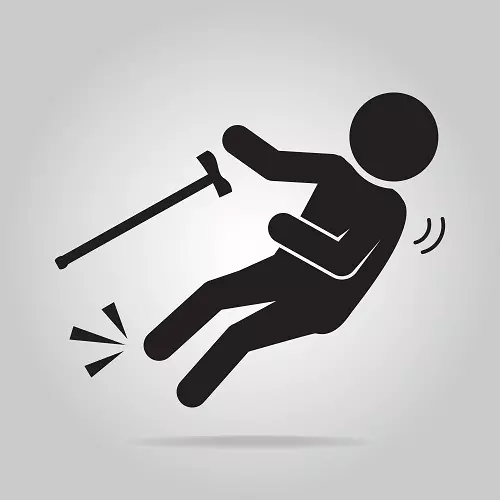
According to the Permanent Survey on Accidents in Daily Life (EPAC) published in 2016, falls account for 80% of accidents in daily life over the age of 65. In fact, ¾ of fall-related deaths of all ages occur in people over 75. Therefore, prevention and detection of falls are essential.
Falls in the elderly are a real public health problem and have been neglected for too long. Therefore, their prevention is based on the detection and treatment of the responsible pathologies. In addition, the part on the research of the factors favoring the risks of falls is essential.
Indeed, the experience of a fall weakens the elderly person, even in the absence of traumatic consequences, and can sometimes constitute a mode of entry into an institution.
Falls in the elderly : a few guidelines
- Every year, 2 million people over 65 years old fall, and among them, 12 thousand die.
- One person out of 2 over 80 years old is a victim.
- 1 fall out of 2 occurs at home during daily activities.
- Victims of outdoor falls tend to be male and younger than victims of indoor falls.
- 40% of people hospitalized after a fall cannot return home.
- The cost of falls among the elderly is estimated at 2 billion euros for communities.
- 646 thousand fatal falls occur each year worldwide, making it the second leading cause of death by unintentional trauma, after road accidents (WHO).
- 1 hour immobilized on the ground means a 50% risk of death in the following 12 months.
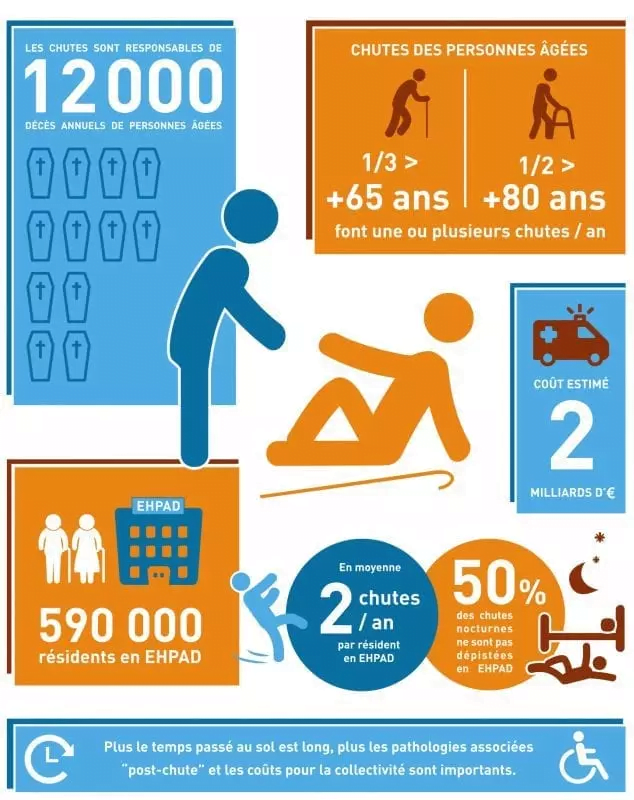
What factors increase the risk of falling?
The cost of falls among the elderly is estimated at 2 billion euros for communities. Therefore, several factors are involved and promote the risk of falling: personal factors (age, health and physical condition), behavioral factors (daily activities at risk) and environmental factors (unsuitable living space).
Falls usually occur during daily activities, whether at home or outside. Moreover, if one fall out of two occurs at home, the most likely place is the bathroom, especially the shower or bathtub. Then, still at home, many obstacles can be the cause of falls such as stairs, carpets, wires on the floor, or poor lighting.
In addition, falls can also occur in a person with impaired alertness because of excessive alcohol consumption or medication. Also, patients with dementia fall more than those without. Of course, walking or balance problems, poorly fitting shoes and visual problems are also the cause of falls among seniors.
Also read : > Infographics: Falls management in care homes, a major challenge
Main causes of falls
The main causes of falls are reduced vision, hearing and balance problems, musculoskeletal problems, cognitive problems (Alzheimer’s, Parkinson’s or other neurodegenerative diseases) or unsuitable footwear…
The circumstances of falls
The circumstances of falls are diverse. Indeed, some are due to the environment and others to the health condition of the person himself. However, most often, these falls occur while walking, during household activities, gardening or simply while getting up from a chair. In addition, accidents can be facilitated by the loss of reflexes, muscle power, vision and sometimes balance.
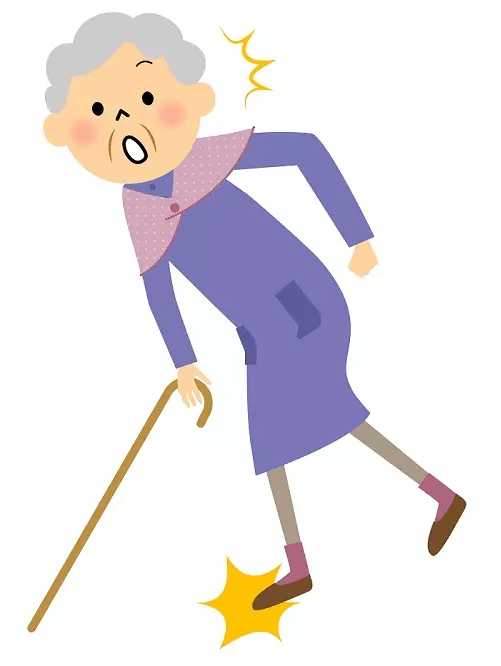
Falls in the elderly are favored by several factors :
Personal factors
- Age: the risk of falls increases with age.
- Motor disorders: walking and balance disorders are frequent with advancing age. Caused in part by muscle wasting, these problems often lead to falls in the elderly. It is recommended to equip oneself with a walking aid, such as a cane or a walker.
- Sensory capacities altered by aging: decrease in vision (cataract, presbyopia, age-related macular degeneration, decrease in visual acuity), hearing disorders (reduced visual field), cognitive disorders.
- Orthostatic hypotension: a drop in blood pressure when the person changes position too quickly.
- Medications that may reduce alertness, quality of vision, etc. Taking more than 3 or 4 medications from 3 classes at the same time (cardiovascular, psychotropic, analgesics) also increases the risk of falling.
Behavioral and environmental factors
Falls can also be caused by risky daily activities: intensive household activities, gardening, etc. In addition, the home itself, if it is not adapted to the needs of its occupant, can be the cause of many accidents.
It may be necessary to adapt the home to the degree of loss of autonomy to limit the risks and to promote a healthy and safe stay at home. Eliminate carpets and other slippery floor coverings, install support bars, ensure the quality of lighting, remove obstacles on the floor or electrical wires lying around…
Risk factors for falls in the home
The risk factors for falls at home recognized as most significant are :
- 3 or more falls in the previous year
- a fall with an injury in the previous year
- difficulty getting up from a chair by oneself
- balance problems, gait problems: osteoarthritis, history of stroke with sequelae, Parkinson’s disease
- orthostatic hypotension with a feeling of dizziness when changing position
- muscular weakness
- problems at the feet level, such as difficulty putting on shoes
- cognitive problems such as dementia
- taking psychotropic drugs
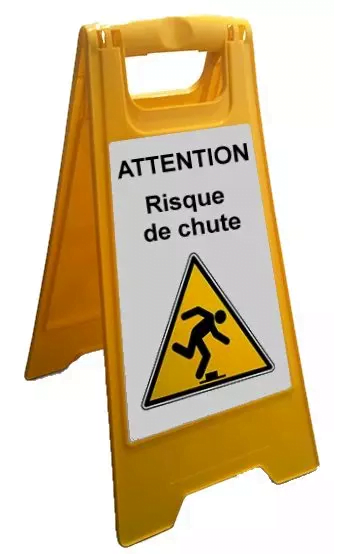
In November 2001, another cause was put forward by an English study. Researchers believe that seniors who suffer from recurrent and unexplained falls may in fact be victims of an undiagnosed heart problem. This condition, called carotid sinus syndrome (CSS), causes very low heart rates and blood pressure. If pressure is applied to the carotid artery, the heart can momentarily stop and cause syncope. Thus, patients are more likely to faint and fall. Since CSS also causes memory loss, the victim will not remember the loss of consciousness before the fall. For these individuals, a pacemaker would help reduce these types of cardiac arrhythmias.
Consequences of falls in the elderly
The consequences of falls are numerous and of several kinds :
- Traumatic consequences: fractures, wounds, contusions, hematomas…
- Psychological:fear of falling again (post-fall syndrome) which leads to postural maladjustment and a reduction in activities.
- Social: reduction of activities which results in a withdrawal and thus a progressive renunciation of one’s social life.
Traumatic consequences
Falls are a frequent reason for hospitalization and admission to the emergency room among the elderly.
Depending on the frailty of the elderly person and the circumstances of the fall, the consequences can be mild or severe, with hospitalization and risk of complications related to forced immobilization.
Among the immediate consequences, fractures and hematoma are to be feared. According to Inserm, more than 50 thousand falls cause a femoral neck fracture in France, often leading to serious consequences and loss of autonomy.
It’s also important to consider the consequences of a prolonged stay on land for a person who has fallen and is unable to get up. A prolonged stay on land can very quickly lead to dehydration, hypothermia, circulatory problems, bedsores, etc.
Post-operative complications of a fracture can also be serious for an elderly and weakened person with risks of infection.
Other consequences are also to be considered, such as the occurrence of behavioral problems or clinical manifestations related to the sudden stop of medication (especially those taken for sleep). After the fall, the elderly person may become fearful, lose his or her autonomy for fear of a relapse, and need help at home, or even leave for an institution. The aftermath of a fall can make it impossible to stay at home and cause a break in social ties.
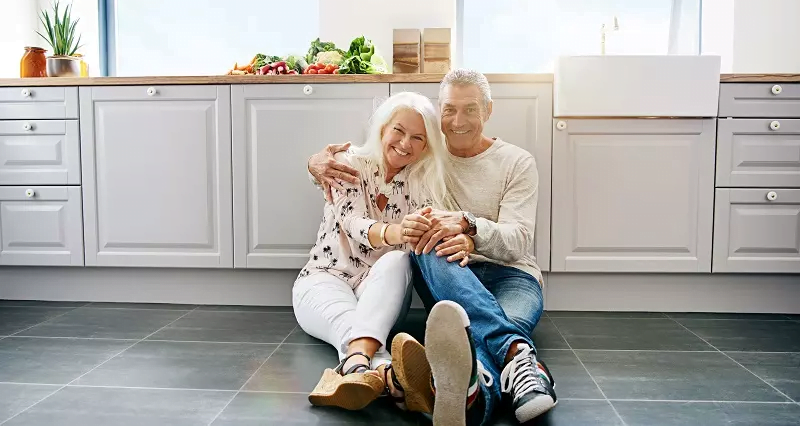
Psychological consequences on autonomy and social life
The consequences of a fall are also psychological (fear of relapse, postural maladjustment, etc.) and social (reduction of activities, withdrawal, etc.).
It has been shown that the longer the time spent on the ground following a fall, the more serious the physiological and psychological consequences. Hence the importance of being able to detect a fall as soon as possible.
How can we prevent falls among seniors?
40% of people hospitalized after a fall cannot return home. But a fall is not inevitable. It can be anticipated thanks to rules of life and vigilance to limit the risks.
Falls at home, risk areas
Falls frequently occur in “high-risk” areas (such as the kitchen or bathroom), in the hallways, on the stairs or in the garden.
Prevention is the only way to avoid a fall. In addition to the classic devices for the development of housing, take care of your health, your diet or practice regular physical activity are recommended.
Adapting your home to limit the risks
How to arrange your home to avoid falls and make it easier to move around safely :
- Do not leave objects on the floor, especially in high-traffic areas (hallway, entrance to a room, stairs).
- Fix the wires of the telephone, lights, television and computer so that they do not get caught in them.
- Make sure that the lighting is strong enough so that there are no dark areas on the way.
- Do not rush if the telephone, doorbell, intercom or knocks on the door are heard.
- Stabilize supports (in the bedroom, bathroom), presence of handrails, and access to calling devices; equip stairs with a ramp.
- Beware of slippery floors, the edges of carpets and pets, which sometimes tend to get into your legs at the risk of making you fall.
- Provide safe and appropriate showers.
- Preferably wear shoes with non-slip soles.
Adopt a healthy and balanced diet
Diet is the basis of a healthy lifestyle. If it is adapted, it can help limit the risk of falls, prevent malnutrition and muscle wasting. Meals must be rich in calcium, proteins, carbohydrates and vitamins, without forgetting to drink enough.
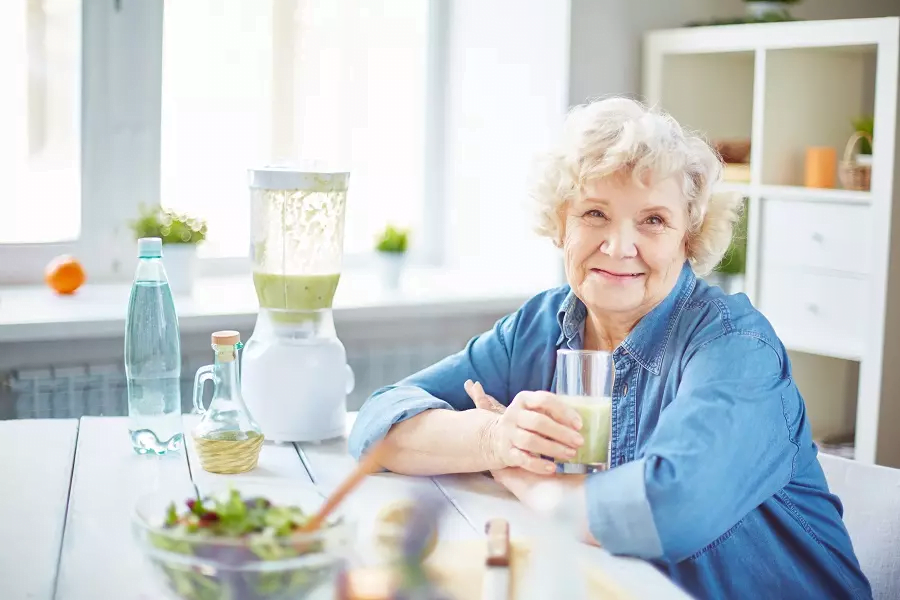
Many elderly people do not eat enough and this deficient nutrition increases the feeling of weakness, dizziness and therefore the risk of falling in the elderly.
It is therefore important to drink regularly and to maintain a sufficient food intake: 1800 kcal for a woman and 2000 kcal for a man.
Moreover, alcohol should be consumed in moderation. Its absorption alters the sensory and motor faculties and is likely to favor falls in the elderly.
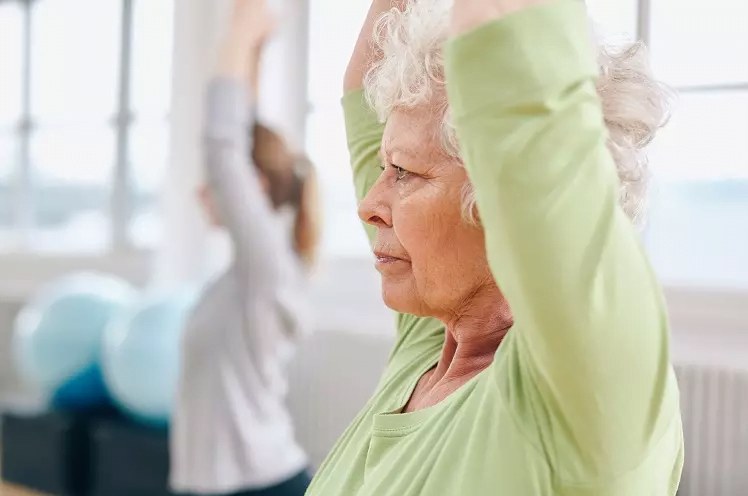
Maintain physical activity at all ages
Practicing a sport or a physical activity adapted to seniors and on a regular basis, such as walking or gentle gymnastics, contributes to preserving reflexes and muscle mass, and therefore, to reducing the risk of falls in the elderly.
Maintaining physical activity also helps prevent osteoporosis, cardiovascular disease, obesity, diabetes, colon cancer and mortality. Every little bit of activity counts and you can start at any age.
It is recommended to do at least 30 minutes of moderate intensity exercise per day (walking, swimming, hiking, biking, stretching, climbing stairs…).
How to get up after a fall ?
Learning how to get up after a fall is essential, but it is before the fall that you should think about it…
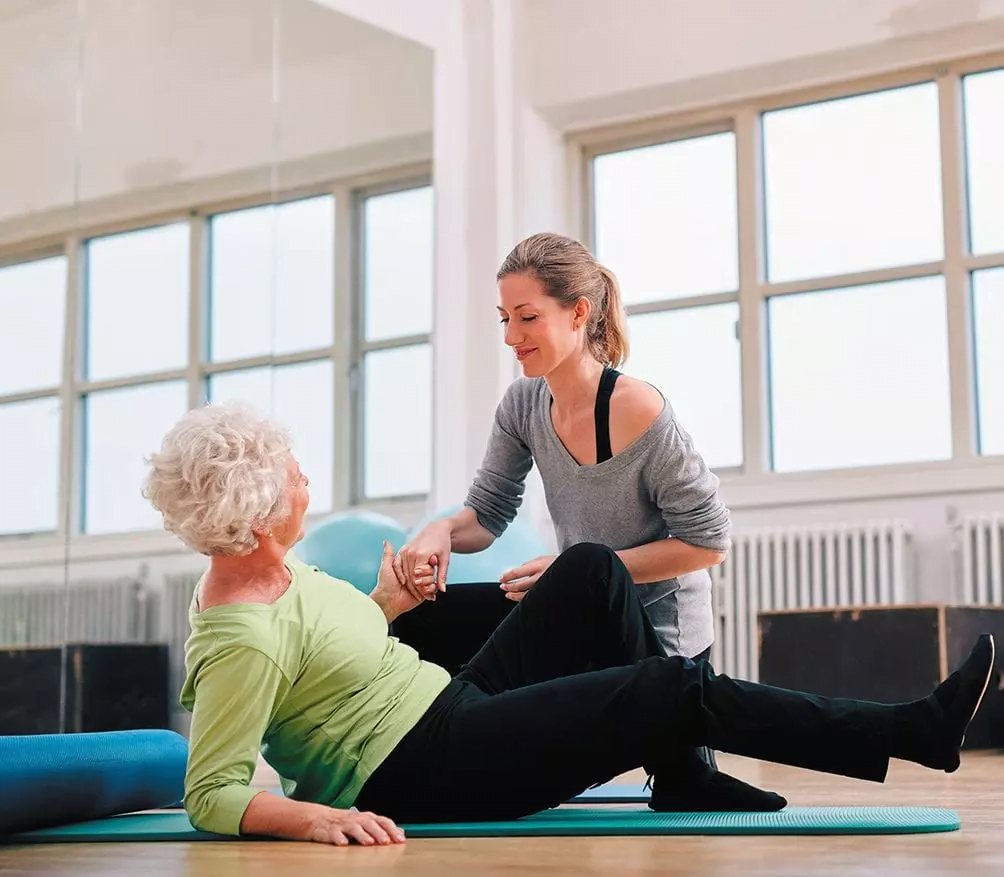
After a fall that did not cause serious injuries, staying on the ground until help arrives is not very pleasant. However, this is what often happens to some elderly people because they do not know how to get back on their feet.
Learning how to get up after a fall is essential. Don’t hesitate to practice, preferably with another person, by following these steps :
- Bend one leg to roll to the side
- Roll over onto your stomach
- Get into a “knight’s position”: one knee on the ground, the other leg extended
- Then on all fours
- Pull yourself up by holding onto a chair or railing
Finally, it may be wise to opt for a tele-assistancesolution, allowing to alert the emergency services or the caregivers in case of need, or if it is impossible to get up.
Elderly people at home : Detecting falls
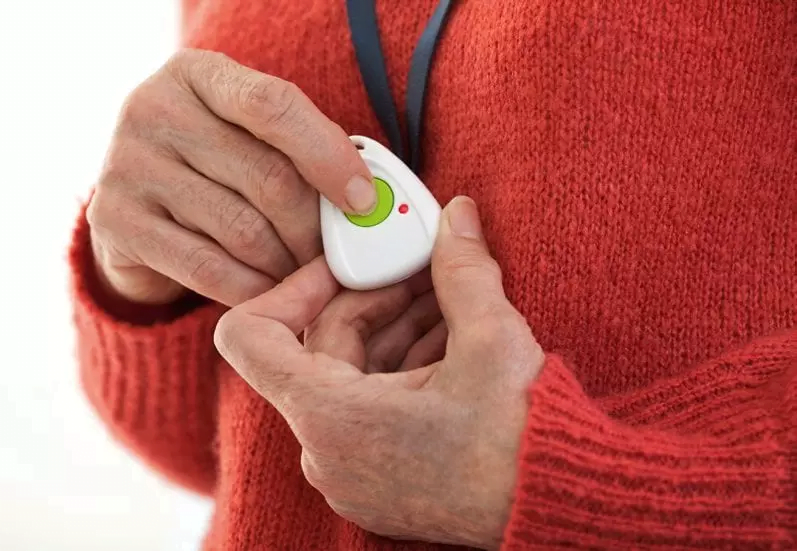
What are the means of detecting and preventing falls, how to get up and what to do to avoid another fall?
If the risks of falling again are multiplied by 20 after the first fall, it is first necessary to know how to identify it before being able to detect it.
There are several types of falls
- Rapid loss of verticality associated with a shock: so-called heavy fall.
- When the person holds on to a piece of furniture, for example: soft fall.
- Syncopal fall: when the person loses consciousness.
However, it is difficult to precisely define all falls, especially since false alarms must also be identified.
The longer the time spent on the ground, the more serious the consequences of the fall. It is therefore essential to be able to detect a fall in order to maintain the autonomy of the elderly.
Although it remains complex to estimate precisely, the overall economic cost of a fall in the elderly is very high, due to the various health costs, including hospitalization, physical and psychological follow-up, and the acceleration of dependence… The interest in working on the detection of falls (without forgetting prevention) in the elderly is therefore major.
In this sense, several solutions for autonomy have been developed and systems have been designed to detect falls and alert quickly in case of problem.
Many researches are in progress to develop devices that do not require an active alert from the victim of a fall (that is to say able to alert even if the person is unconscious.
There are various types of devices designed to detect a fall in an elderly person :
- Those that detect the fall itself (a sudden, rapid movement, or the shock wave on the ground).
- Devices that detect the prolonged horizontal position of the body after the fall.
- Technologies that detect sudden and prolonged cessation of daily activities or movement.
- Those that track the person’s biological data (heart rate and blood pressure).
- And finally, products that combine these different techniques.
Published by the Editorial Staff on
